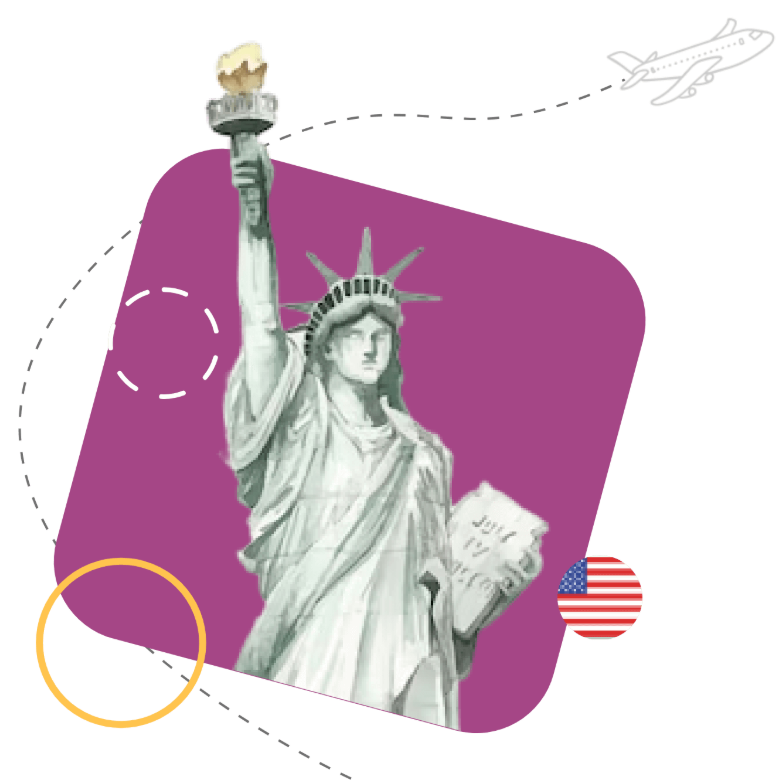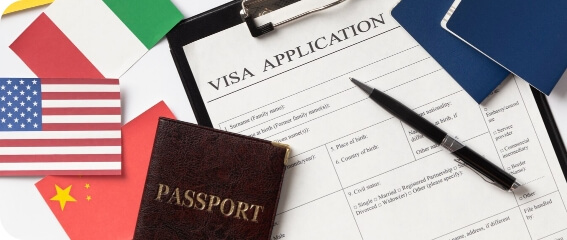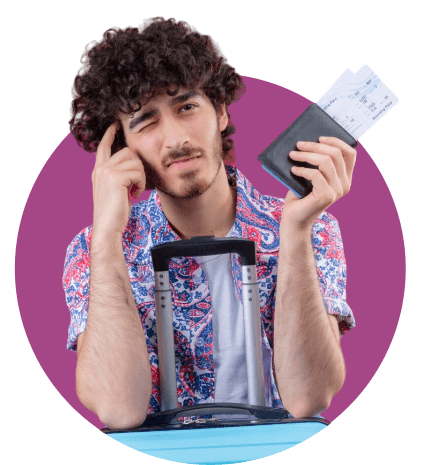Study In USA


Why study in the USA?
Education System in the USA
The education system in the USA operates on a grading scale, where students receive letter grades representing different points per credit hour, contributing to their GPA (grade point average):
- A: 4 points (the highest grade)
- B: 3 points (above-average performance)
- C: 2 points (average passing grade)
- D: 1 point (minimum passing grade)
- F: No credit, zero points (indicating failure)


Semester System
The academic year is divided into two semesters:
- Fall: Typically 16 weeks starting in mid-August or September.
- Spring: Also 16 weeks starting in January, with a short winter break and a longer summer vacation.
Quarter System
- The academic year is divided into three quarters.
- Start date: Usually late September until mid-June.
Duration of Programs:
- Bachelor (Undergraduate): Typically 4 years.
- Master (Graduate): Generally 2 years.
- MBA: Ranges from 2 to 3 years.

Educational Requirements To Study In The USA
These Requirements Ensure That Students Are Academically Prepared For Their Chosen Programs And Can Succeed In Their Studies In The USA. AE Overseas Assists Students In Understanding And Meeting These Requirements For A Smooth Application Process.
| Higher Study Options | Minimum Educational Requirement | Minimum Required Percentage | IELTS/PTE/ TOEFL Score | Backlogs Information | Other Standardized Tests |
|---|---|---|---|---|---|
| Bachelors | 12 Years Of Education (10+2) | 60% | Overall 6, With 5.5 In Each Band | Up To 10 Backlogs Accepted (Some Private Universities May Accept More) | The Minimum SAT Score Required Is 1350 Out Of 1600 |
| Masters (MS/MBA) | 4-Year Graduate Degree | Overall 6.5, With No Band Less Than 6 | GRE: 310/GMAT: 520 (MBA Programs May Require 3-4 Years Of Work Experience) | Very Few Universities Accept A 3-Year Bachelor's Degree, NAAC Accredited A+ Or A |
Benefits Of Studying In America
Studying In The USA Offers Numerous Advantages, Particularly In Fostering Career Development And Growth. Here Are Some Key Benefits
Wide Range of Academic Programs
Access a diverse array of academic programs, enabling students to explore various fields of study tailored to their interests and career goals.
Cultural Diversity and Exposure
Engage in a country known for its diversity, fostering cross-cultural understanding and global perspectives.
Best Scope for Career Growth
Acquire skills and knowledge necessary for career advancement, leveraging the prestigious reputation of American universities and the opportunities available in the US job market.
English Language Proficiency
Top-Ranked Universities
Global Recognition of Degrees

| Higher Study Options | Part-time work duration allowed | Post-study work permit |
|---|---|---|
| Bachelors | 20 Hours per week | STEM profile get 3 years OPT, Non-STEM gets 1 year OPT (Optional Practice Training) |
| Masters (MS/MBA) |
Other benefits for international students include are as above,
Top Universities In The USA
Popular Public Universities In The USA
Explore The Following Public Universities In The USA, Each Offering Diverse Academic Programs And Scholarship Opportunities Annually; These Institutions Provide Affordable Tuition Fees And Various Scholarship Programs, Making Them Excellent Choices For Students Seeking Quality Education And Financial Assistance.

- University Of Florida
- Ohio State University
- University of California, San Diego
- University of Michigan
- University of Washington
- North Carolina State University
- University of Georgia
- University of Texas at Austin
- University of North Carolina at Chapel Hill
- University of California, Berkeley
- University of Wisconsin Madison
- Georgia Institute of Technology (Georgia Tech)
- University of Virginia
Study Intakes In The USA
The USA offers three main intakes for students to choose from, depending on their course and university preferences.
| Intake | Study Program | Admission Deadlines |
|---|---|---|
| Summer | Undergraduate and Postgraduate | May - September |
| Spring | January - May | |
| Fall | September - December |

Cost of studying in the USA
Public-Funded Universities
Tuition expenses for international students at state schools are typically based on non-resident costs, which are generally more affordable compared to private universities. This cost estimate excludes student visa fees.
Private Institutions
Private universities may have higher tuition fees compared to public-funded universities.
On average, international students can expect to spend approximately $15,000 to $55,000 annually to cover tuition fees when studying in the USA. This amount may vary depending on factors such as the chosen university, program of study, and any additional expenses such as accommodation and living costs.

| Types Of Expenses | Annual Expenses in USD |
|---|---|
| Tuition Fees for one-year (Indicative)* | 25000 |
| Living and Accommodation | 15000 |
| Airfare from India to USA | 1000 |
| Visa Fees (Visa & SEVIS) | 535 |
| Total Expenses | 41535 |
Scholarships To Study In The USA
AE Overseas facilitates access to a variety of scholarships for international students wishing to study in the USA. These scholarships include fully funded opportunities, merit-based awards, tuition fee waivers, and more. For detailed information, Please Click On The Provided Link.
| Name Of The Scholarship | Amount (Per Year) |
|---|---|
| BrokerFish International student scholarship | $12,000 USD |
| Next Genius Scholarship | Up to $100,000 |
| The University of Chicago Scholarships | Up to $20,000 |
| Knight-Hennessy Scholars at Stanford University | Up to $90,000 |
| AAUW International Fellowships | $18,000 |
| Microsoft Scholarships | Up to $12,000 USD |
| Microsoft Scholarships | Up to $12,000 USD | Fulbright Foreign Student Program in the USA | $12,000 to $30,000 |
| Hubert Humphrey Fellowships | $50,000 |
| Berea College Scholarships | 100% Scholarship |
These scholarships provide valuable financial support to international students, making studying in the USA more accessible and affordable.
Eligibility Requirements For Students In US Universities
AE Overseas Ensures That Students Meet The Necessary Eligibility Criteria For Studying In US Universities, Providing Comprehensive Guidance On Various Aspects Of Student Visas And Dependent Visas.
Student Applicant
Students Aiming To Study In US Universities Must Meet Specific Eligibility Criteria
- Age Requirement
Applicants Must Be Over 18 Years Of Age.
- On-Campus Work
International Students Are Permitted To Work On Campus For Up To 20 Hours Per Week During Academic Terms And Full-Time During Literary Break Periods, Including The Summer.
- Off-Campus Work
Off-campus employment necessitates written or documented authorization issued by either the USCIS or OISS. To be eligible for any form of off-campus employment, students must be in legal status and enrolled as F-1 visa students in the US for at least one academic year.
After Graduation
Upon Graduation, F1 Student Visa Holders Are Eligible For Up To 12 Months Of Optional Practical Training (OPT). This Temporary Employment Permission Enables Students To Gain Practical Experience In Their Field Of Study. After The OPT Period, Students Must Apply For A Work Visa To Continue Employment In The US. However, Students Can Remain In The US For Up To 60 Days After Completing Their Course, Even Without A Job Offer Or OPT Application.
Student Dependent Visa
The F2 Visa Is A Non-Immigrant Dependent Visa For The Immediate Family Members Of F1 Student Visa Holders. Eligibility Conditions For The F2 Visa Include Being The Spouse Or Dependent Child (Under 21 Years And Unmarried) Of An F1 Visa Holder. Applicants Must Demonstrate Sufficient Financial Resources To Support Their Family In The US.
Benefits of F2 Visa
- Extended Visa Stays
F2 visa dependents are eligible to apply for an extension if the primary F1 visa holder extends their stay.
- Change of Visa Status
F2 visa holders can request a change of visa status to F1 by enrolling in a US university or finding suitable employment.
- Green Card Eligibility
- Access to Healthcare
F2 visa holders have access to medical services in the US, although obtaining health insurance is advisable.

F2 Visa Restrictions
- No permission to work
- Not eligible for Social Security Number
- Not allowed to pursue higher education
M1 Visa – Student Visa (Vocational Course)
The M1 Visa Is Issued To International Students Pursuing Vocational Training In The US. It Enables Students To Undertake Full-Time Vocational Studies And Offers Certain Privileges Such As Obtaining A Driver’s License And Access To Healthcare Services.
Requirements For M1 Visa Application
Applicants Must Meet Specific Requirements, Including Minimum Education Qualifications, Admission To A US-Based Educational Institution, Proficiency In English, Financial Stability, Intention To Return To Their Home Country After Education Completion, And Assurance That Their Education Will Benefit Their Home Country.
Documents Required
- Valid Passport
- DS-160 Confirmation
- Fee Receipts
- Educational Certificates
- Visa Appointment Letter
- Recent Photographs
- Proof Of Financial Stability
- Valid Passport
- DS-160 Confirmation
- Fee Receipts
- Educational Certifiactes
- Visa Appointment Letter
- Recent Photographs
- Proof of Financial Stability
Additionally, M1 Visa Holders Can Apply For Full-Time Employment Outside The Campus Or Study Full-Time Courses As Part-Time Operations With Strict Attendance Monitoring.
Why Apply For A US Student Visa?
Why Settle For Less When You Can Aim For The Best? Here’s Why You Should Apply For A US Student Visa Through AE Overseas
Access To Top-Ranked Universities
Choose From 260 QS Ranking Universities, Ensuring A World-Class Education.
One Year Of Post-Study Work Permit
Gain Valuable Work Experience With A Post-Study Work Permit, Enhancing Your Career Prospects.
Affordable Tuition Fees
Public Universities Offer Tuition Fees Ranging From $10,388 To $12,000, Making Quality Education Accessible.
Lucrative Scholarships
Benefit From Scholarships Ranging From $10,000 To $100,000, Easing The Financial Burden Of Education.
Quick Visa Processing
Get Your Visa Processed Within 3 To 5 Months, Ensuring A Smooth Transition To Studying Abroad.
High Visa Approval Rate
USA Student Visa Eligibility
Enrollment In A SEVP-Approved School
Apply To A School In The USA That Is Approved By The Student And Exchange Visitor Program (SEVP).
Full-Time Enrollment
Language Proficiency
Financial Proof
Residency Outside The USA


USA Student Visa Requirements
To Apply For A USA Student Visa, You’ll Need To Gather The Following Documents
- Confirmation page of DS-160.
- Educational transcripts.
- Form I-20 issued by the institution.
- Payment receipt for SEVIS application fees.
- Language proficiency certification.
- Application as a non-immigrant.
Be sure to check with your chosen university or college for any additional requirements specific to their institution.
How to Apply for a USA Student Visa?
Embarking on your journey to study in the USA is an exciting step towards your future. Here’s a simple guide on how to apply for a USA student visa:

Check Your
Eligibility
Ensure you meet the eligibility criteria for a US student visa, including enrollment in a SEVP-approved institution and sufficient financial resources.

Gather Required Documents
Prepare all necessary documents, including educational transcripts, proof of financial funds, and language proficiency certification.

Apply
Online
Complete the online application for a USA student visa (Form DS-160) on the official website of the US Department of State.

Await
Approval
After submitting your application, await approval from the US embassy or consulate in your country. This process may take several weeks, so be patient.

Travel to the
USA
Once your visa is approved, it’s time to pack your bags and embark on your journey to the USA for your education.
USA Student Visa Cost

USA Student Visa Processing Time
Processing Time
The processing time for a US student visa varies depending on the visa type you apply for. Generally, F-1 student visa processing may take approximately 3-6 weeks. However, this timeline can extend up to 4 months if there are inaccuracies or discrepancies in the submitted documents.
Important Tip
Before applying for the US Study Visa, meticulously review all required documents to ensure accuracy and completeness. This proactive step can help expedite the processing time and avoid unnecessary delays.
Track Your Visa Status
After submitting your visa application, you can conveniently track the status of your visa through the embassy’s portal. Stay informed about the progress of your application to better plan your travel and academic arrangements.
Optional Practical Training (OPT)
- International Students Planning To Work In Non-STEM Fields Can Apply For Optional Practical Training (OPT).
- OPT Can Be Pursued Either During Or After Completing Your Academic Program.
- For Non-STEM Programs, OPT Offers A One-Year Work Visa.
STEM Programs
- For Students In STEM (Science, Technology, Engineering, And Mathematics) Fields, The USA Offers An Extended Three-Year Work Visa Through The OPT Program.
These Post-Study Work Visa Options Provide International Students With Valuable Opportunities To Gain Practical Experience In Their Respective Fields And Enhance Their Career Prospects In The USA.






